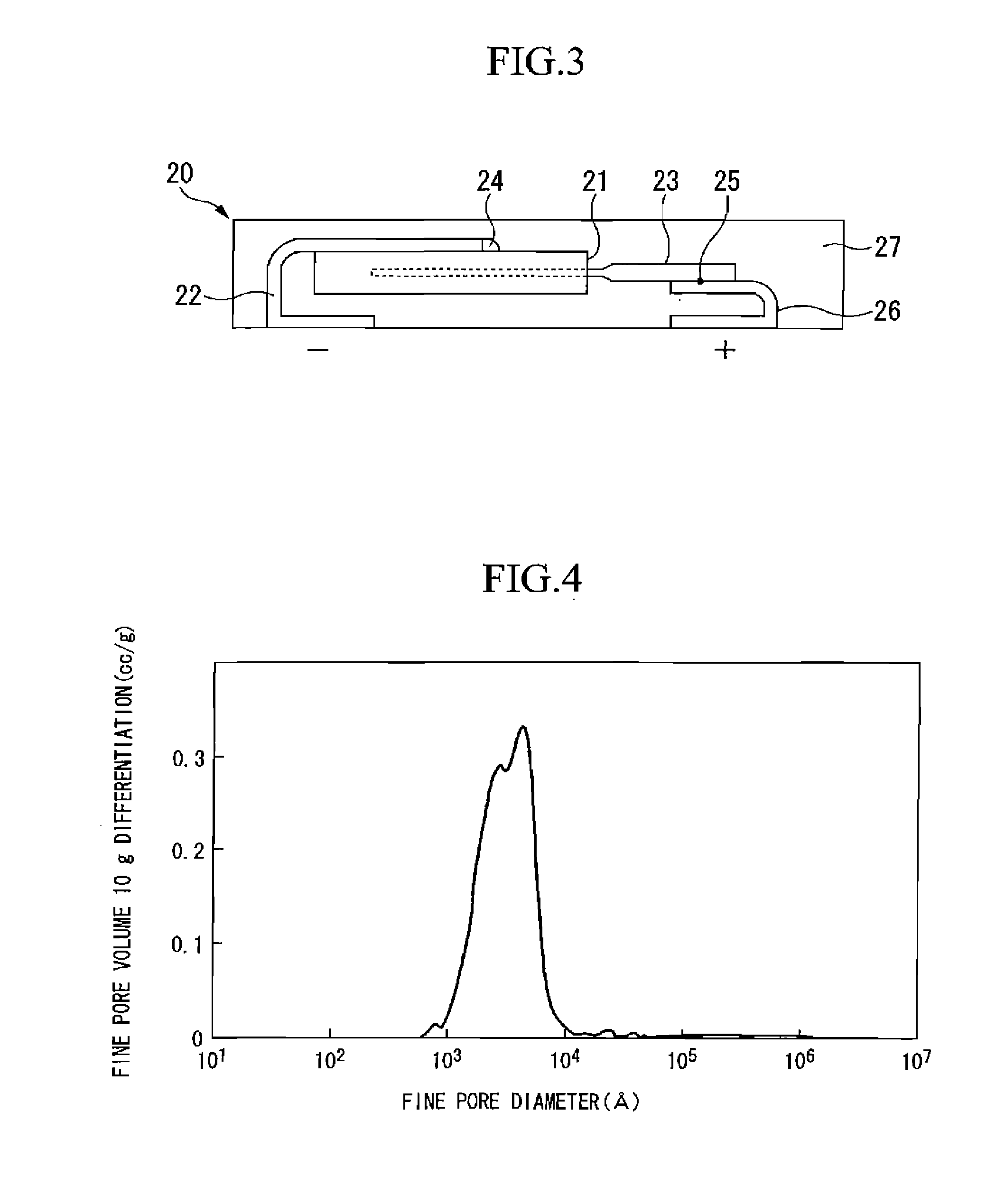Process for Producing Porous Sintered Metal
a technology of porous sintered metal and process, which is applied in the manufacture of electrolytic capacitors, separation processes, filtration separation, etc., can solve the problems of inability to achieve the desired structure of sintered metal, difficulty in obtaining a sintered body, and clogging of pores, etc., to achieve uniform shape and size, small pore diameter, and high porosity
- Summary
- Abstract
- Description
- Claims
- Application Information
AI Technical Summary
Benefits of technology
Problems solved by technology
Method used
Image
Examples
first embodiment
[0036]A first embodiment of a process for producing a porous sintered metal of the present invention is described. The production method of the first embodiment is a so-called dry method, in which firstly a mixture containing a metal powder, a pore forming material, and a binder resin is filled into a mold, so as to form a molding by means of press molding or the like. Subsequently, the molding is heated at the decomposition temperature of the pore forming material to thereby effect thermal decomposition of the pore forming material. Then the molding is sintered at a sintering temperature higher than the decomposition temperature, so as to form a porous sintered metal.
[0037]The metal material constituting the metal powder is not particularly limited and examples include at least one type of Fe, Ni, Co, Cr, Mn, Zn, Pt, Au, Ag, Cu, Pd, Al, W, Ti, V, Mo, Nb, Zr, and Ta, or an alloy containing at least one type thereof. Preferably the metal powder has a purity of 99.5% or more, and is a...
second embodiment
[0058]A second embodiment of the process for producing a porous sintered metal of the present invention is described.
[0059]The production method of the second embodiment is a wet method in which firstly a metal powder, a pore forming material, a binder resin, and a solvent are mixed and dispersed, so as to prepare preferably a paint-like metal powder dispersion. The metal powder dispersion is coated or printed on a base material to form a coated material or printed material. Then the base material is detached from the coated material or printed material, to form a molding. The step for forming a porous sintered metal from the molding is the same as that of the fist embodiment. In the production method of the second embodiment, for the metal powder, and the pore forming material, those from the first embodiment can be used, and for the binder resin, those from the first embodiment which are soluble in a solvent can be used, and thus the description thereof is omitted.
[0060]Examples o...
example 1
[0085]50 g of tantalum powder S-15 (manufactured by Cabot Supermetals K.K.) having an average primary particle diameter of 0.1 μm and a capacitance of 150 kCV / g, 0.5 g of PHBH resin beads (manufactured by Kanegafuchi Kagaku K.K., 1% by weight with respect to tantalum powder) having an average primary particle diameter of 1 μm as a pore forming material, 7.5 g (solid content; 3 g) of acrylic resin “NCB-166” (manufactured by Dainippon Ink and Chemicals, Inc., glass transition point; −10° C.) as a binder resin, 4.8 g of cyclohexanone (solvent), and 300 g of zirconia having a diameter of 3 mm, were placed in a plastic bottle, and mixed and dispersed using a shaker (paint conditioner), so as to obtain a tantalum powder dispersion.
[0086]On the other hand, a solution of an acrylic resin “IB-30” (manufactured by Fujikurakasei Co., Ltd.) was coated on a PET film having a thickness of 50 μm by a #16 wire bar, to provide a release layer having a thickness of 4 μm.
[0087]Next, the metal powder d...
PUM
| Property | Measurement | Unit |
|---|---|---|
| particle diameter | aaaaa | aaaaa |
| particle diameter | aaaaa | aaaaa |
| pore diameter | aaaaa | aaaaa |
Abstract
Description
Claims
Application Information
 Login to View More
Login to View More - R&D
- Intellectual Property
- Life Sciences
- Materials
- Tech Scout
- Unparalleled Data Quality
- Higher Quality Content
- 60% Fewer Hallucinations
Browse by: Latest US Patents, China's latest patents, Technical Efficacy Thesaurus, Application Domain, Technology Topic, Popular Technical Reports.
© 2025 PatSnap. All rights reserved.Legal|Privacy policy|Modern Slavery Act Transparency Statement|Sitemap|About US| Contact US: help@patsnap.com



